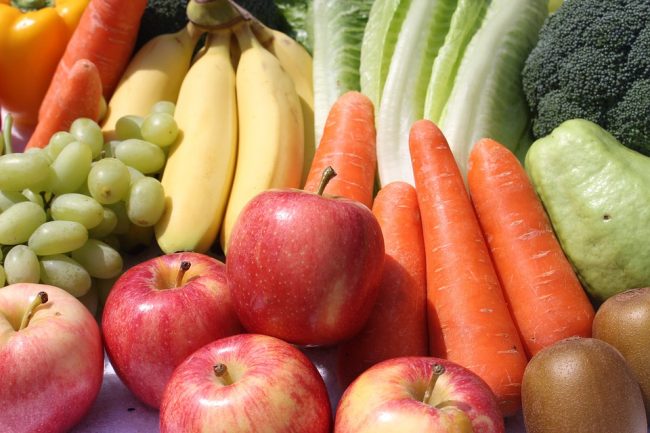The Benefits of Colorful Fruits & Vegetables
The majority of people know that eating five servings of fruits and vegetables a day is very important.
By eating fruits and vegetables of a variety of different colors, one can get the best all-around health benefits. Each different color fruit and vegetables contains unique health components that are essential to our health.
Fruits and vegetables are very important to our health because they are whole foods, created by nature, that are rich in a large amount of nutrients. The processed foods that we so commonly eat, can never compare to the health benefits provided by strawberries or broccoli, which have fiber, vitamins, and enzymes built right in.
Eating plenty of healthy vegetables and fruits helps prevent heart disease and strokes, diverticulitis, control your blood pressure, prevent some types of cancers, and guards against cataract and macular degeneration or vision loss.
Red Fruits and Vegetables
Contain nutrients such as lycopene, ellagic acid, Quercetin, and Hesperidin, to name a few. These nutrients reduce the risk of prostate cancer, lower blood pressure, reduce tumor growth and LDL cholesterol levels, scavenge harmful free-radicals, and support join tissue in arthritis cases.
Orange and Yellow fruits and vegetables
Contain beta-carotene, zeaxanthin, flavonoids, lycopene, potassium, and vitamin C. These nutrients reduce age-related macula degeneration and the risk of prostate cancer, lower LDL cholesterol and blood pressure, promote collagen formation and healthy joints, fight harmful free radicals, encourage alkaline balance, and work with magnesium and calcium to build healthy bones.
Green vegetables and Fruit
Green vegetables contain chlorophyll, fiber, lutein, zeaxanthin, calcium, folate, vitamin C, calcium, and Beta-carotene. The nutrients found in these vegetables reduce cancer risks, lower blood pressure and LDL cholesterol levels, normalize digestion time, support retinal health and vision, fight harmful free-radicals, and boost immune system activity.
Blue and purple fruits and vegetables
Contain nutrients which include lutein, zeaxanthin, resveratrol, vitamin C, fiber, flavonoids, ellagic acid, and quercetin. Similar to the previous nutrients, these nutrients support retinal health, lower LDL cholesterol, boost immune system activity, support healthy digestion, improve calcium and other mineral absorption, fight inflammation, reduce tumor growth, act as an anticarcinogens in the digestive tract, and limit the activity of cancer cells.
White fruits and vegetables
Contain nutrients such as beta-glucans, EGCG, SDG, and lignans that provide powerful immune boosting activity. These nutrients also activate natural killer B and T cells, reduce the risk of colon, breast, and prostate cancers, and balance hormone levels, reducing the risk of hormone-related cancers.
Chart of Colored Vegetables and Fruit
(See bottom of page for printable chart)
| Green – Artichokes, Arugula, Asparagus, Avocados, Broccoflower, Broccoli, Broccoli rabe, Brussel sprouts, Celery, Chayote squash, Chinese cabbage, Cucumbers, Endive, Green apples, Green beans, Green cabbage, Green grapes, Green onion, Green pears, Greenpeppers, Honeydew, Kiwifruit, Leafy greens, Leeks, Lettuce, Limes, Okra, Peas, Snow Peas, Spinach, Sugar snap peas, Watercress, Zucchini |
| White – Bananas, Brown pears, Cauliflower, Dates, Garlic, Ginger, Jerusalem artickoke, Jicama, Kohlrabi, Mushrooms, Onions, Parsnips, Potatoes, Shallots, Turnips, White Corn, White nectarines, White peaches |
| Red – Beets, Blood oranges, Cherries, Cranberries, Guava, Papaya, Pink grapefruit, Pink/Red grapefruit, Pomegranates, Radicchio, Radishes, Raspberries, Red apples, Red bell peppers, Red chili peppers, Red grapes, Red onions, Red pears, Red peppers, Red potatoes, Rhubarb, Strawberries, Tomatoes, Watermelon |
| Yellow/Orange – Apricots, Butternut squash, Cantaloupe, Cape Gooseberries, Carrots, Golden kiwifruit, Grapefruit, Lemon, Mangoes, Nectarines, Oranges, Papayas, Peaches, Persimmons, Pineapples, Pumpkin, Rutabagas, Sweet corn, Sweet potatoes, Tangerines, Yellow apples, Yellow beets, Yellow figs, Yellow pears, Yellow peppers, Yellow potatoes, Yellow summer squash, Yellow tomatoes, Yellow watermelon, Yellow winter squash |
| Blue/Purple – Black currants, Black salsify, Blackberries, Blueberries, Dried plums, Eggplant, Elderberries, Grapes, Plums, Pomegranates, Prunes, Purple Belgian endive, Purple Potatoes, Purple asparagus, Purple cabbage, Purple carrots, Purple figs, Purple grapes, Purple peppers, Raisins |
The phrase “eating a rainbow” of fruits and vegetables is a simple way of remembering to get as much color variety in your diet as possible, so that you can maximize your intake of a broad range of nutrients. The colors of fruits and vegetables are a small clue as to what vitamins and nutrients are included. By getting a variety of different colored fruits and vegetables, you are guaranteed a diverse amount of essential vitamins and minerals.
According to the food pyramid potatoes are not counted as a vegetable, as they are consist mostly of starch and should be consumed sparingly.
Freezing Fruits and Vegetables:
To preserve for consumption during the winter or off season see which fruits and vegetables you can freeze.
The nutrients found in the above fruits and vegetables have a significant impact on our health.
Quercetin, which is found in apples, onions and other citrus fruits, not only prevents LDL cholesterol oxidation, but also helps the body cope with allergens and other lung and breathing problems.
Ellagic acid, which is mainly found in raspberries, strawberries, pomegranates, and walnuts, has been proven in many clinical studies to act as an antioxidant and anticarcinogens in the gastrointestinal tract. This nutrient also has been proven to have an anti-proliferative effect on cancer cells, because it decreases their ATP production.
The best-known of the carotenoids, beta-carotene, is converted into vitamin A upon entering the liver. Although being known for its positive effects on eyesight, it has also been proven to decrease cholesterol levels in the liver.
Clinical studies have proven that lycopene, mainly found in tomatoes, may decrease the risk of prostate cancer, as well as protect against heart disease. Lutein, which is found in blueberries and members of the squash family, is important for healthy eyes. However, it does support your heart too, helping to prevent against coronary artery disease.
Along with the above stated nutrients, there are even more nutrients found in fruits and vegetables that provide a great deal of support to our body. Almost everyone has heard of vitamin C, which keeps our immune system strong; speeds wound healing, and promote strong muscles and joints. This nutrient is scattered throughout the spectrum of fruits, but commonly associated with oranges and other citrus fruits. Potassium, which is the nutrient most Americans are deficient in, does great things for our hearts, and lowers blood pressure.
Another good food component many people don’t get enough of if fiber, found in fruits, vegetables, and whole grains.
Flavonoids, which include anthocyanins, flavones, isoflavones, proantocyanidins, quercetin and more, are found almost everywhere. They are responsible for the colors in the skins of fruits and vegetables and help to stop the growth of tumor cells and potent antioxidants. They also can reduce inflammation.
Beta-glucan, found in mushrooms, stabilizes and balances the body’s immune system by supporting white blood cells. EGCG is found in tea and has been shown to reduce the risk of colon and breast cancer. It boosts the immune system and encourages T-cell formation, which defends our body against sickness and disease.
Bioflavonoids, which are found in citrus fruits, are considered a companion to vitamin C because they extend the value of it in the body. These nutrients have the capabilities to lower cholesterol levels and support joint collagen in arthritis cases.
The number one excuse for not eating the required five servings of fruits and vegetables each day is they are too expensive. However, as compared to the amount of money spent on prepackaged, processed, and fast foods, most fruits and vegetables (with the exception of those that are not in season) are not all that expensive.
Because frozen fruits and vegetables retain the majority of their nutritional value, they can be an excellent alternative when certain foods are out of season.
Someone who is not able to eat five servings of fruits and vegetables each day can also drink fruit and vegetable drinks in their place. Although this shouldn’t become a habit, fruit and vegetable drink mixes can be an excellent substitute when you’re rushed or traveling.
The need for fruits and vegetables in our diet is growing rapidly with the type 2 diabetes, heart disease, and high cholesterol, hypertension that result from the “Typical American Diet” of fatty meats, processed sugars, and refined grains.
Great fruit drink Mixes and vegetable mixes can be found at your local health food store or internet health food store.
Fruit and Vegetable Color Chart you can Print out.
Right click the chart below and select print.

Check out this link to 19 Awesome Tips and Tricks to Freeze Vegetables created by ElectroSaw HQ!





